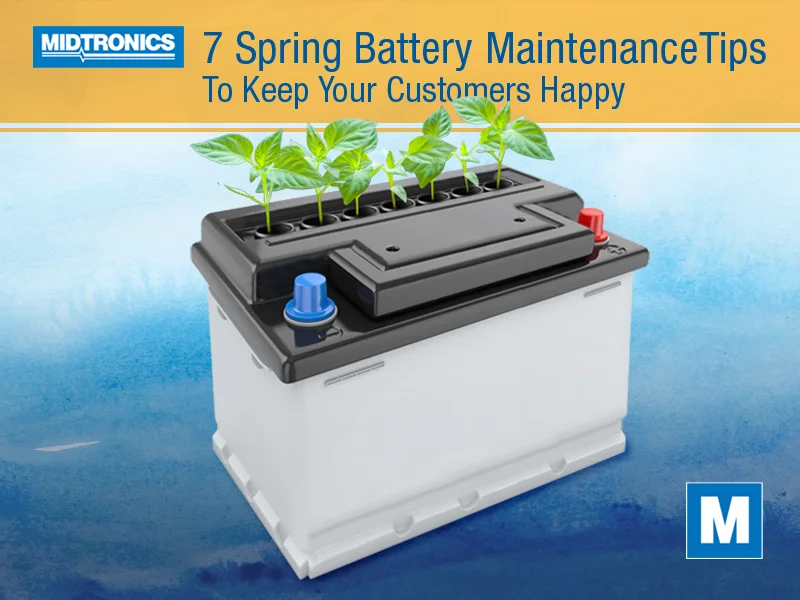As the winter weather abates and the threat of snow and cold is in the rearview mirror, there tends to be an influx of appointments at dealerships and service shops. Let’s face it, winter weather can be harsh on many aspects of a vehicle, and car batteries certainly aren’t exempt. Cold temperatures slow down the chemical reactions inside a battery, reducing its ability to hold a charge, and they’re forced to work harder in the winter since the engine oil thickens and tolerances tighten, requiring more effort and energy to overcome it and start the engine. That doesn’t even factor in the extra load that heaters, defrosters, and lights put on the battery.
When customers arrive for their service appointment, spring battery maintenance may not be on their radar, but it should be on yours. Mitigating the winter’s effect on a battery not only is a great way to extend battery life and ensure vehicle reliability, but it can also help earn trust with your customers and increase revenue. Here are seven spring battery maintenance tips that can elevate your shop above the others around you.
Perform a Complimentary Battery Test
Regardless of a vehicle’s age and condition, a battery test that’s performed when the vehicle arrives for its service appointment is always good practice. It’s especially true after a hard winter season that’s put stress on the 12-volt battery. It’s at this point that a battery may be weaker than it was entering the winter, and it may not last through the stressful summer when loads from heater fans and AC compressors are consistent.
Verify that the battery’s voltage, cold cranking amps, and reserve capacity still meet or exceed the rating on the battery’s label. Complete a starting and charging system test as well for additional peace of mind for the owner, winning you their trust.
Inspect the Battery Case
For technicians in extreme climates, bulging battery cases aren’t a foreign sight. It happens all too easily when a partially or fully discharged battery begins to freeze, and it can be a hazard even if it passes a test in the moment. The bulged case indicates that something inside is structurally compromised, and it’s possible that a failure could occur weeks or even months down the road.
Whenever you encounter a bulged battery case – even if it isn’t cracked and leaking – the safe bet is to recommend a replacement to the vehicle owner. Since it’s something that can be seen, a brief explanation is often all it takes for a customer to get on board and do something about it.
Tighten Connections
The laws of physics are on full display throughout the winter season, and materials expanding and contracting can be expected to occur. However, it’s not always considered as it relates to car batteries and the connections made at the terminals. When cold temperatures arrive, cycles of contraction can occur that slightly loosen connections, but expansion in the spring doesn’t necessarily mean the terminals will be tight again.
Part of spring maintenance packages can include checking the battery connections and tightening them as required. This simple step that takes but a few seconds can save a frustrated customer returning later in the year with electrical issues or a no-start related to loose battery terminals.
Clean the Battery
Corrosion on the battery can occur at any time of the year, and whether it’s due to heat cycles or overcharging, acid can seep from the top posts. The collection of white and pastel-colored corrosion on the posts and cables will eventually erode it, increase resistance, and prevent a connection altogether, causing annoying problems that could’ve been avoided with preventative maintenance.
Offer battery services upon noticing corrosion or leakage on the top of the battery case. This simple service takes the technician only a few minutes and can add a much-needed boost to your average labor per work order while serving the customer’s needs.
Check the Battery Age
With flooded lead-acid batteries typically lasting three to five years and advanced chemistries like AGM and EFB batteries typically five to eight years, there’s a good benchmark for when to expect you’ll need to replace a customer’s battery. Even when it’s performing as expected, it’s a good plan to check the battery’s age. When it’s nearing the average end of its lifecycle, it never hurts to let the vehicle owner know.
It may not be the right time to recommend a replacement if the battery test passes, but it puts it on the customer’s radar for future consideration. That way, the next time they’re in for service and the battery doesn’t test perfectly any longer, it isn’t a surprise that they need to replace it.
Inspect the Belts and Pulleys
Winter is harsh on all kinds of parts and systems, and if you’ve found on a complimentary battery test that it isn’t at full voltage, it could be a problem with charging. The alternator or serpentine belt may not be in the greatest condition anymore, or the tension may not be enough due to a weak or seizing pulley or tensioner.
A routine check of belts and pulleys is a good idea for the vehicle owner’s peace of mind whether there are symptoms or not, and it’s again a step that takes almost no time to complete.
Recharge if Required
Did the battery test return a result of ‘Good – Recharge’? Why not serve the customer to the highest standard and put a battery charger on it while it’s in for the rest of its maintenance and repairs? Again, this simple step takes essentially no time as other tasks can be performed simultaneously, and the customer benefits from a topped-up battery, demonstrating you’ve gone above and beyond what’s required.
Spring is a reprieve from harsh weather extremes, and it’s a great chance to address battery issues with your customers before they become more serious and annoying problems. Plus, it’s an excellent opportunity to display the highest level of care and concern with some really simple steps.




